
A beautiful view of the 7-mile causeway leading from mainland Utah to the Antelope Island and its State Park. This stretch of travels wraps up my visit to Utah, and takes me starting my eastward trek through the beautiful state of Wyoming. I got to visit with some former coworkers, and took in the many sites and scenery of these two wonderful states. I visited a state capital, a Disney inspired house, and a gas chamber used in the mid 19th century to execute death row inmates at a state penitentiary. All the gory details follow in this edition of the Luv2RV Blog.
Salt Lake City, UT
It’s been quite a while since I’ve been in this area – likely upwards of 8 or more years. Back in my working days, I had opened 2 thousand-seat Obamacare/ Medicare call centers here in Utah. Building out the IT infrastructure and hiring several onsite support techs to provided ongoing IT support is what I spent the entire summer of 2013 doing. The call center business was sold off in 2018, soon after I left the company. But, I was fortunate to have contacted two of my former workmates, and arranged get togethers with each of them.
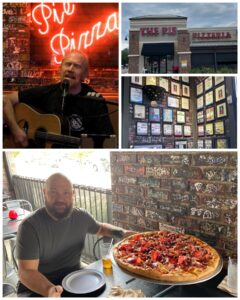 One of my must do’s while here in the Salt Lake area is to visit my favorite pizza place – simply called The Pie. As luck would have it, one of my former coworkers suggested we get together there for lunch the day after my arrival. Certainly no need to twist my arm! So, I met up with Joe (pictured at left, bottom), and I ordered their largest 23-inch all meat behemoth (I wanted to make sure Joe and I would have leftovers). We enjoyed this spectacular pizza, while chatting and catching up. It was great to see and spend time with Joe again. Thanks for taking the time to share a lunch! The other Pie reference that I thoroughly enjoy is a musician named Mike Massé. Starting back in the late 90’s, this full-time practicing defense attorney shared his talents and love of music by playing gigs at The Pie the first Friday of each month. He was also scholastically trained as a sound engineer, and he used those talents to professionally record his gigs, then posted them on his YouTube channel. He developed quite the following, including me, and eventually amassed lots of views. With years of video postings and continued growth this new found fame allowed him to give up his lawyer job to perform music full time. Today, his YouTube videos have been watched millions of times, with the most popular one with 17M views being his cover of Africa by Toto. He performed this song with his base playing buddy Jeff Hall back in 2010 at this exact location (watch it HERE). He’s an amazing cover artist and I’ve been a huge fan of his music for quite some time. I’ve been following his YouTube and other social channels as well hoping that his tour schedule would bring him to an area near me some day. As luck would have it, a couple months ago he announced a Feb 2024 gig in Claremont, FL – not far from where I spend my winters. I jumped at the opportunity to get a ticket to see him and not only scored one, but was fortunate to get a VIP ticket which included front row seating and a personal meet and greet. I’m so excited and can’t wait to see him live in concert.
One of my must do’s while here in the Salt Lake area is to visit my favorite pizza place – simply called The Pie. As luck would have it, one of my former coworkers suggested we get together there for lunch the day after my arrival. Certainly no need to twist my arm! So, I met up with Joe (pictured at left, bottom), and I ordered their largest 23-inch all meat behemoth (I wanted to make sure Joe and I would have leftovers). We enjoyed this spectacular pizza, while chatting and catching up. It was great to see and spend time with Joe again. Thanks for taking the time to share a lunch! The other Pie reference that I thoroughly enjoy is a musician named Mike Massé. Starting back in the late 90’s, this full-time practicing defense attorney shared his talents and love of music by playing gigs at The Pie the first Friday of each month. He was also scholastically trained as a sound engineer, and he used those talents to professionally record his gigs, then posted them on his YouTube channel. He developed quite the following, including me, and eventually amassed lots of views. With years of video postings and continued growth this new found fame allowed him to give up his lawyer job to perform music full time. Today, his YouTube videos have been watched millions of times, with the most popular one with 17M views being his cover of Africa by Toto. He performed this song with his base playing buddy Jeff Hall back in 2010 at this exact location (watch it HERE). He’s an amazing cover artist and I’ve been a huge fan of his music for quite some time. I’ve been following his YouTube and other social channels as well hoping that his tour schedule would bring him to an area near me some day. As luck would have it, a couple months ago he announced a Feb 2024 gig in Claremont, FL – not far from where I spend my winters. I jumped at the opportunity to get a ticket to see him and not only scored one, but was fortunate to get a VIP ticket which included front row seating and a personal meet and greet. I’m so excited and can’t wait to see him live in concert.
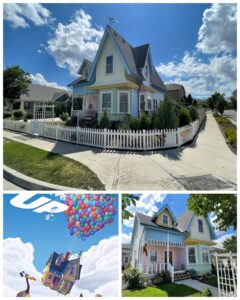 After lunch with Joe, I got a much needed haircut, then headed out to to the west a bit to Harriman, UT to check out an interesting Roadside attraction. There, I visited a house that was designed and built modeled from the house featured in the Disney movie Up. The house was created by Bangerter Homes, who actually obtained permission and assistance from Disney/Pixar in order to get it right. Supposedly, this will be the one and only such home built as Disney will not provide said permission a second time. It was built in 2011 and was open to the public through the Parade of Homes that year. It was sold to a Disney-loving family in 2012 who continue to occupy it to this day. Inside tours are not offered, but a short documentary featuring the owners was filmed about 4 years ago (watch it HERE), and clearly shows many of the inside rooms are designed and furnished in total alignment with the movie. It’s definitely a cool place to visit, but I’m sure I’d not want to live there.
After lunch with Joe, I got a much needed haircut, then headed out to to the west a bit to Harriman, UT to check out an interesting Roadside attraction. There, I visited a house that was designed and built modeled from the house featured in the Disney movie Up. The house was created by Bangerter Homes, who actually obtained permission and assistance from Disney/Pixar in order to get it right. Supposedly, this will be the one and only such home built as Disney will not provide said permission a second time. It was built in 2011 and was open to the public through the Parade of Homes that year. It was sold to a Disney-loving family in 2012 who continue to occupy it to this day. Inside tours are not offered, but a short documentary featuring the owners was filmed about 4 years ago (watch it HERE), and clearly shows many of the inside rooms are designed and furnished in total alignment with the movie. It’s definitely a cool place to visit, but I’m sure I’d not want to live there.
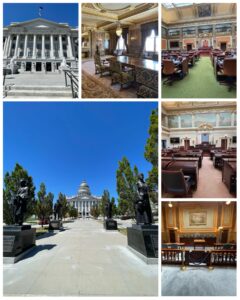 The next day I traveled to downtown SLC to visit the State Capital building. And what a magnificent building it was! A classy statue-lined promenade led up the front steps of the building. The statues were of various local prominent people that held particular historic value with the state. In 1850, the capital of the Utah Territory, then made up of all present day Utah, most of Nevada, and parts of western Colorado and southwestern Wyoming, was located in Filmore, UT – somewhat central to the area. Shortly thereafter, realizing that the population had not centralized as anticipated, Fillmore was deemed too remote, and in 1856, the capital was moved to SLC. This capital building has been one of Utah’s most prominent landmarks and has been home to state government since its opening in 1916. The
The next day I traveled to downtown SLC to visit the State Capital building. And what a magnificent building it was! A classy statue-lined promenade led up the front steps of the building. The statues were of various local prominent people that held particular historic value with the state. In 1850, the capital of the Utah Territory, then made up of all present day Utah, most of Nevada, and parts of western Colorado and southwestern Wyoming, was located in Filmore, UT – somewhat central to the area. Shortly thereafter, realizing that the population had not centralized as anticipated, Fillmore was deemed too remote, and in 1856, the capital was moved to SLC. This capital building has been one of Utah’s most prominent landmarks and has been home to state government since its opening in 1916. The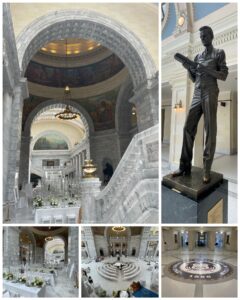 legislature was not in session, so I got to see the Senate, House, and Supreme Court rooms where all the business takes place. Those were nicely appointed.
legislature was not in session, so I got to see the Senate, House, and Supreme Court rooms where all the business takes place. Those were nicely appointed.
Inside, the building is filled with extensive art pieces and lots of stonework. White marble and/or granite throughout is complimented by the colorful murals around the dome. It really is a beautiful building. Apparently, it is available for private functions, and it would appear based on the setup activity that was going on at the time, that a wedding was to take place there later on in the day. As I was touring the 4th floor of the building, I happened upon a familiar statue. Philo Farnsworth, the inventor of the television as reported in the last edition of the blog, is also recognized here in the capital. In fact, this is the same exact bronze statue as the one sitting outside the city hall in Beaver, UT. So apparently, Philo is well respected and recognized here in Utah.
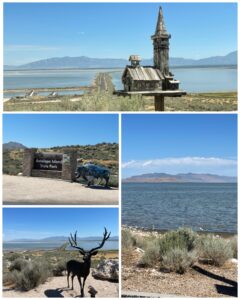 The next day, I took a drive out to Antelope Island State Park. This 42 square miles of animal sanctuary, accessible via a 7-mile causeway, is the largest of ten islands within the Great Salt Lake. It has beautiful mountains and lots of grass filled prairies which is ideally suited to its animal inhabitants. In the early 1900s, there was a movement to designate Antelope Island as a National Park, but that effort never materialized. Inststead, the state of Utah turned it into a State Park in 1981. Early in its history, the island was actually privately owned and was originally used as a cattle and sheep ranch by the Mormon pioneers from 1848 thru 1870. John Dooley Sr. purchased the island
The next day, I took a drive out to Antelope Island State Park. This 42 square miles of animal sanctuary, accessible via a 7-mile causeway, is the largest of ten islands within the Great Salt Lake. It has beautiful mountains and lots of grass filled prairies which is ideally suited to its animal inhabitants. In the early 1900s, there was a movement to designate Antelope Island as a National Park, but that effort never materialized. Inststead, the state of Utah turned it into a State Park in 1981. Early in its history, the island was actually privately owned and was originally used as a cattle and sheep ranch by the Mormon pioneers from 1848 thru 1870. John Dooley Sr. purchased the island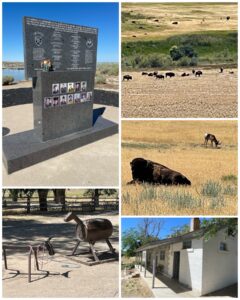 in 1870 and continued to use it for ranching until it was sold to the state of Utah in 1981. The sheep and cattle were subsequently removed and the island became the state park.
in 1870 and continued to use it for ranching until it was sold to the state of Utah in 1981. The sheep and cattle were subsequently removed and the island became the state park.
The scenic drive leads south and at the 11-mile mark, I visited Garr Ranch – dating back to the 1800s is purported to be the oldest Utah building still on its original foundation. I also visited the memorial that stands at the entrance to the park (at right, top left) which commemorates the 12 lives lost from the Oct 29, 1992 crash of a helicopter from Hill AFB carrying both Army and Air Force SOCOM personnel that were on a routine joint training mission. Lastly, the island is reportedly rich with bison, bighorn sheep,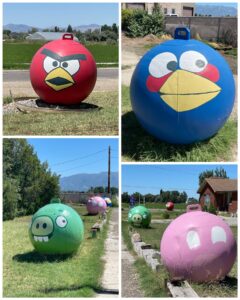 mule deer, and pronghorn antelope. I’m wondering though if the island should be renamed to Bison Island as but for the last 5 minutes of my visit where I spotted a single mule deer, bison was the only thing I had seen. I’m not sure where all the rest of the animals were hiding.
mule deer, and pronghorn antelope. I’m wondering though if the island should be renamed to Bison Island as but for the last 5 minutes of my visit where I spotted a single mule deer, bison was the only thing I had seen. I’m not sure where all the rest of the animals were hiding.
On the way to Antelope Island, a few miles before the causeway along Antelope Island Rd, I spotted these giant steel spheres painted in tribute to the widely popular characters from the game Angry Birds. These were located in the front and side yard of a private residence occupied by the Schofields. They were so cool I just had to stop and take some pictures. Interestingly, these cool attractions were surprisingly absent from my ever popular app Roadside America. So, being the stoic contributor that I am, I submitted the pictures and all the other important details to Roadside America so that they could be added to the roadside list. Time will tell if this submission will be accepted, but I have no doubt that it will.
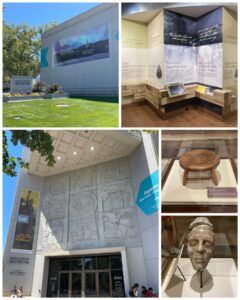 Next, I spent the better part of the day exploring downtown SLC. First up on the hit list was a visit to the Church History Museum of The Church of Jesus Christ of Latterday Saints – aka the Mormon Church. I didn’t know very much about Mormon history, and I figured a visit to this museum would fill in some of the gaps. While it did have a wonderful collection of Mormon artifacts, and presented an interesting 15 minute video, I frankly left there not knowing much more about its history. The museum seemed to focus more to the religious aspects of Morman life, than the historical events and timeline that led up to its establishment as a
Next, I spent the better part of the day exploring downtown SLC. First up on the hit list was a visit to the Church History Museum of The Church of Jesus Christ of Latterday Saints – aka the Mormon Church. I didn’t know very much about Mormon history, and I figured a visit to this museum would fill in some of the gaps. While it did have a wonderful collection of Mormon artifacts, and presented an interesting 15 minute video, I frankly left there not knowing much more about its history. The museum seemed to focus more to the religious aspects of Morman life, than the historical events and timeline that led up to its establishment as a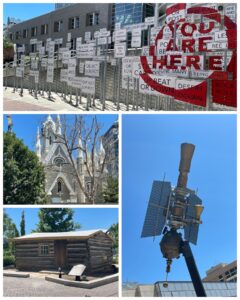 religion. But none the less, it was a very beautifully done museum.
religion. But none the less, it was a very beautifully done museum.
I then proceeded to wander around downtown SLC, in an area known as Temple Square, to take in some other of its interesting sites. Behind the museum was this pioneer cabin, built in 1847. This 10×20 ft historical home is representative of the early Mormon settlers. Assembly Hall (at left, center left) is a gothic revival style building completed in 1882 and was built as a place of worship for local LDS congregations. A collection of more than 150 crazy road signs featuring cryptic messages like “Break And Fix”, “You Are Here”, and “Straight Curve” makes for an interesting photo op along W Temple St in front of the Salt Palace Convention Center. It was created by Maine artist Aaron T Stephan and was unveiled in 2016. Definitely interesting! Last up is this crazy looking thing (at left, bottom right) that sat atop a pole along W Temple St in front of the Utah Museum of Contemporary Art. It was among several art pieces on poles in front of the museum, and the one that I found most interesting. I could not find any information specifically about this piece, but I presume it is part of the contemporary collection.
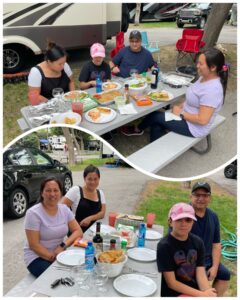 On Monday of that week’s stay in SLC, I had the pleasure of hosting a lasagna dinner party with one of my former coworkers and his family. I hired Jim back in 2013 to provide desktop support for one of the newly opened ObamaCare/Medicare call centers. Though that line of business has since been sold off, Jim still works for General Dynamics, but now as part of a specialized IT team. He and his wife Shiela, daughter Hailey, and special guest his visiting sister-in-law Chai, came down from Ogden to the KOA where I was staying to take part in some of my world famous lasagna. That, combined with the empanadas that Shiela made, and the bottles of wine Jim brought, made for an absolutely wonderful meal. I had met Jim’s family many years before, back when Hailey was just a toddler, who has since nicely evolved into wonderful tween. It was really nice seeing them again and catching up. Thanks for making the trip down to SLC.
On Monday of that week’s stay in SLC, I had the pleasure of hosting a lasagna dinner party with one of my former coworkers and his family. I hired Jim back in 2013 to provide desktop support for one of the newly opened ObamaCare/Medicare call centers. Though that line of business has since been sold off, Jim still works for General Dynamics, but now as part of a specialized IT team. He and his wife Shiela, daughter Hailey, and special guest his visiting sister-in-law Chai, came down from Ogden to the KOA where I was staying to take part in some of my world famous lasagna. That, combined with the empanadas that Shiela made, and the bottles of wine Jim brought, made for an absolutely wonderful meal. I had met Jim’s family many years before, back when Hailey was just a toddler, who has since nicely evolved into wonderful tween. It was really nice seeing them again and catching up. Thanks for making the trip down to SLC.
 On my last full day in Salt Lake, I headed out to visit a few interesting Roadside attractions. A couple of them were very nicely done art pieces created by the same artist. Stephen Kessler made this 33 foot long, 13 feet high Red Iguana that sits in the parking lot of a restaurant of the same name. It is a super realistic looking creature that took him two years to make, and includes over 120,000 individually hand-sculpted scales and 80 epoxy spines. Truly amazing! Stephen also crated this 23 foot high 40 feet wide rainbow-colored humpback whale breaching out of the dirt in this traffic circle located in a residential neighborhood. It too was really amazing. Last up, Roadside sometimes brings me to a cemetery to visit the gravesite of some famous or interesting person. This time, it was not necessarily the person that was particularly famous, but rather the unique and interesting memorial that adorned their grave. Mathew Stanford Robison was just 10 years old when he died in 1999. Due to a lack of oxygen at birth, he was
On my last full day in Salt Lake, I headed out to visit a few interesting Roadside attractions. A couple of them were very nicely done art pieces created by the same artist. Stephen Kessler made this 33 foot long, 13 feet high Red Iguana that sits in the parking lot of a restaurant of the same name. It is a super realistic looking creature that took him two years to make, and includes over 120,000 individually hand-sculpted scales and 80 epoxy spines. Truly amazing! Stephen also crated this 23 foot high 40 feet wide rainbow-colored humpback whale breaching out of the dirt in this traffic circle located in a residential neighborhood. It too was really amazing. Last up, Roadside sometimes brings me to a cemetery to visit the gravesite of some famous or interesting person. This time, it was not necessarily the person that was particularly famous, but rather the unique and interesting memorial that adorned their grave. Mathew Stanford Robison was just 10 years old when he died in 1999. Due to a lack of oxygen at birth, he was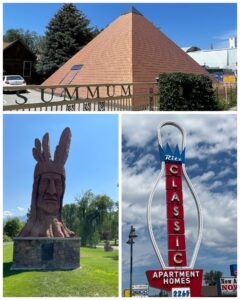 born blind and partially paralyzed and was not expected to have a long life. At his death, his father had this memorial created of Mathew rising up out of his wheelchair to depict him in the afterlife – free from his earthly afflictions. I have to admit, this memorial gave me goosebumps. It was really moving.
born blind and partially paralyzed and was not expected to have a long life. At his death, his father had this memorial created of Mathew rising up out of his wheelchair to depict him in the afterlife – free from his earthly afflictions. I have to admit, this memorial gave me goosebumps. It was really moving.
Located in Murray City Park, another of Peter Toth’s Trail of the Whispering Giants Indian head carvings is the Utah representative of this series. Chief Wasatch was dedicated here in 1985 and is number 52 in the series. I took a couple of pictures with the statue, including a selfie, and sent them to my now text buddy Peter. Next, this tall neon bowling pin sign used to advertise the 54 lanes of the Ritz Classic Bowl. The bowling alley was demolished in 2015, but locals wanted the iconic sign to remain. Today, it advertises an apartment complex. Lastly, if you’ve ever thought about having yourself mummified after death, this 40 foot wide by 26 feet tall pyramid featuring the headquarters of Summum is the place to go. The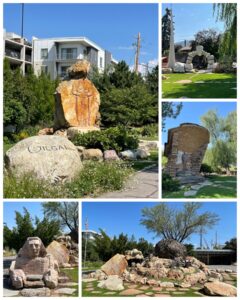 Summum is the only religion in the world that believes in and still practices mummification. Prices start at $15k for a small pet, and increase to about $67k for a human. Yea, no thanks!
Summum is the only religion in the world that believes in and still practices mummification. Prices start at $15k for a small pet, and increase to about $67k for a human. Yea, no thanks!
My next stop in my SLC tour was to Gilgal Garden. Gilgal is an Old Testament word meaning “circle of stones”. This half acre stone garden is the work of Thomas Battersby Child. He was a stonemason that died in 1963 but his last 18 years were spent in his back yard creating these obscure stone art pieces with lots of Mormon religious references. Left to his kids at his death, they were about to sell the land to a condo developer. The local art community, the state government, and the LDS church stepped in and outbid the Canadian company and instead converted the property to a state park where it will be preserved and protected. Most of the artifacts are strange and in many cases, apparently not fully understood. For example, there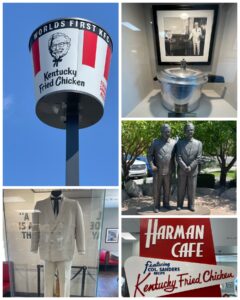 is a giant sphinx with the head of Mormon prophet Joseph Smith. Or, the life size statue of himself wearing brick pants. Anyway, it was an odd if not interesting garden.
is a giant sphinx with the head of Mormon prophet Joseph Smith. Or, the life size statue of himself wearing brick pants. Anyway, it was an odd if not interesting garden.
My final stop in the SLC area was to take a trip down to Murray to visit the very first Kentucky Fried Chicken franchise. Corbin, KY is where Colonel Sanders first sold his chicken, but he also recognized the potential of the franchising concept. Thus, the first KFC franchise was hatched here in Murray, UT. That franchise concept has certainly grown as KFC is the second largest restaurant chain (2nd to McDonald’s), with over 22,000 locations in 150 countries. Outside is a bronze statue of the Colonel along with Pete Harman, who was the first franchisee who opened the first franchise on this very spot in 1952. Inside the restaurant is a nice collection of historical pieces – including one of the Colonel’s signature white suits, some vintage chicken pressure cooking gear, and the original signage from back in the day. Since I was there anyway, I figured I’d stop and have some lunch. It was indeed finger lickin’ good!
Lyman, WY
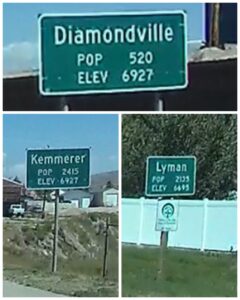 After a glorious 6 weeks of touring all through Utah, it was time to start making my way toward the east. My first top in that direction would take me to Layman, WY. It, and the many towns around it, are truly representative of small town America. With populations of around 2k or less, I was transformed from the SLC big city experience to the pleasures of quaint little towns having their own unique flare and offerings. Lyman itself only really had a single point of interest which was the Jim Bridger Trading Post and Fort Bridger historic
After a glorious 6 weeks of touring all through Utah, it was time to start making my way toward the east. My first top in that direction would take me to Layman, WY. It, and the many towns around it, are truly representative of small town America. With populations of around 2k or less, I was transformed from the SLC big city experience to the pleasures of quaint little towns having their own unique flare and offerings. Lyman itself only really had a single point of interest which was the Jim Bridger Trading Post and Fort Bridger historic site.
site.
Jim Bridger was perhaps the best known and most travelled mountain man, and is considered one of Americas greatest frontiersman. He was a trapper, fur trader Army scout, and wilderness guide who explored all through the west. He was well travelled and was among the first mountain men to explore the regions of Yellowstone and the Great Salt Lake. There are several statues of Bridger including one in Missouri, one in Montana, and the one here in Wyoming. He built this trading post in the 1840s as a money-making general store to provide supplies to pioneers traveling along the Oregon Trail. Being the great explorer himself, he was also providing useful insight and advice to those travelers.
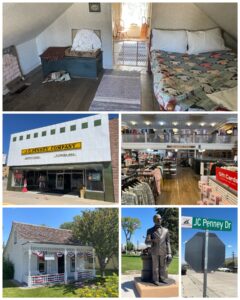 About 40 miles north is the town of Kemmerer, WY, with a unique history of its own. A man named James Cash Penney (aka JC Penney) opened his first store here in 1902. Born in Missouri in 1875, he abandoned his plans for college and a career as a lawyer to care for his family following his father’s untimely death. He worked as a store clerk for a small chain of stores called the Golden Rule stores. Co-owners of the Golden Rule were so impressed with his work ethic and salesmanship, they offered him a one-third partnership. James moved to Kemmerer and after contributing $2,000, he opened his first Golden Rule store (pictured at left, middle left). By 1907, co-owners dissolved their partnership and James purchased full ownership. By 1912, there were 34 stores in the Rocky Mountain region when he moved the headquarters to Salt Lake City and incorporated under the new name J.C. Penney Company. Besides his first store (known as the Mother Store), the house in which he lived at the time still stands and is now a museum. Apparently there were no night depositories back in those days so interestingly, there was a secret hidden compartment (at left, top, left side) in the upstairs bedroom of his home where he would hide the receipts of the days sales until the next morning when the bank was open when he could then make the deposit. Like many other brick & mortar companies of late, JCPenney has been through some hard times, having only about 700 stores today from a one-time high of over 2,000 in the mid 1970s. I enjoyed visiting this store in Kemmerer with its creaky wooden floor, and original multi-tiered format that was prevalent in the design of many of the stores. It also had that historic smell that’s hard to describe, but is present in many old retail buildings. Pretty cool to have all this in a town of just over 2,000.
About 40 miles north is the town of Kemmerer, WY, with a unique history of its own. A man named James Cash Penney (aka JC Penney) opened his first store here in 1902. Born in Missouri in 1875, he abandoned his plans for college and a career as a lawyer to care for his family following his father’s untimely death. He worked as a store clerk for a small chain of stores called the Golden Rule stores. Co-owners of the Golden Rule were so impressed with his work ethic and salesmanship, they offered him a one-third partnership. James moved to Kemmerer and after contributing $2,000, he opened his first Golden Rule store (pictured at left, middle left). By 1907, co-owners dissolved their partnership and James purchased full ownership. By 1912, there were 34 stores in the Rocky Mountain region when he moved the headquarters to Salt Lake City and incorporated under the new name J.C. Penney Company. Besides his first store (known as the Mother Store), the house in which he lived at the time still stands and is now a museum. Apparently there were no night depositories back in those days so interestingly, there was a secret hidden compartment (at left, top, left side) in the upstairs bedroom of his home where he would hide the receipts of the days sales until the next morning when the bank was open when he could then make the deposit. Like many other brick & mortar companies of late, JCPenney has been through some hard times, having only about 700 stores today from a one-time high of over 2,000 in the mid 1970s. I enjoyed visiting this store in Kemmerer with its creaky wooden floor, and original multi-tiered format that was prevalent in the design of many of the stores. It also had that historic smell that’s hard to describe, but is present in many old retail buildings. Pretty cool to have all this in a town of just over 2,000.
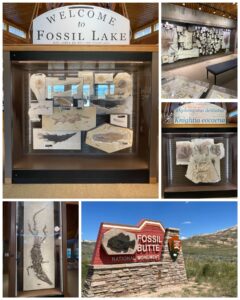 The house museum tour guide was very knowledgeable and sharing regarding JC Penney history. After chatting a bit with her, she asked if I had been to Fossil Butte. I had not, and in fact did not even have it on my itinerary. She said it was a great NPS managed place, was only about 15 miles away, and highly encouraged me to take a visit. So I took her advice and headed there next. Fossil Butte was established as a National Monument in 1972, and holds and preserves one of the largest and best aquatic fossil collections in North America, and perhaps the world. Fossils of fish, alligators, turtles, insects, and lots of other aquatic animals and plants, were 50 million years in the making in Fossil Lake – the smallest of three great lakes which once existed in the areas of Wyoming, Utah, and Colorado. The monument is made up of only 13 square miles of the more than 900 square miles once occupied by the ancient lake. Their visitor center was filled with over 80 fossils of all sorts that were found in the region, and also contains a working lab where the public can observe as fossils are prepared. I’m really glad I got this recommendation as otherwise, I would likely have missed this gem.
The house museum tour guide was very knowledgeable and sharing regarding JC Penney history. After chatting a bit with her, she asked if I had been to Fossil Butte. I had not, and in fact did not even have it on my itinerary. She said it was a great NPS managed place, was only about 15 miles away, and highly encouraged me to take a visit. So I took her advice and headed there next. Fossil Butte was established as a National Monument in 1972, and holds and preserves one of the largest and best aquatic fossil collections in North America, and perhaps the world. Fossils of fish, alligators, turtles, insects, and lots of other aquatic animals and plants, were 50 million years in the making in Fossil Lake – the smallest of three great lakes which once existed in the areas of Wyoming, Utah, and Colorado. The monument is made up of only 13 square miles of the more than 900 square miles once occupied by the ancient lake. Their visitor center was filled with over 80 fossils of all sorts that were found in the region, and also contains a working lab where the public can observe as fossils are prepared. I’m really glad I got this recommendation as otherwise, I would likely have missed this gem.
Rawlins, WY
 My second of three stops in WY would take me to the town of Rawlins. I was only to be here for two nights, so my touring time was limited. I did take my one and only full day there to check out several Roadside items of interest right there in downtown Rawlins. A circa 1920’s era restored Texaco station was my first stop. Though it was not open for an inside tour, the outside was filled with antique period-correct gas pumps, an old Texaco fuel delivery truck, and an original Texaco sign. Very cool! Just down the road at a Conoco station was this interesting 1955 Series 62 dual headed Cadillac. Said to be the work of T.R. Bob Perkins, he found these two front halves in a junkyard, and decided it would be fun to join them together. He did so in 1962, and the car has been on display here at the Conoco station since. It reportedly does have a working engine and steering on both ends, and is driven several times a year in local parades and car shows. Now thats cool! Last up was this mural that depicts Thomas Edison enjoying a vacation there in Rawlins. Unfortunately there was a damn car parked immediately in front of the mural, despite the entire rest of the parking lot being empty. Anyway, Edison apparently came here in 1878 to observe a solar eclipse, and to test some device he had that measured temperature. He pointed the device at the sun’s corona during the eclipse, and it apparently burned up. Left with nothing else to do, he opted to go fishing. It was there that locals believe he ultimately invented the light bulb. Though he had been working on the bulb for some time, it was the filament that was giving him trouble. Legend says that it was the bamboo fishing pole that he was using at the time that gave him the idea to use bamboo as the filament – which ultimately proved successful. Thus, one of Rawlins claims to fame it that it is home to the invention of the light bulb. Sounds like a bit of a stretch, but ok I guess that is feasible.
My second of three stops in WY would take me to the town of Rawlins. I was only to be here for two nights, so my touring time was limited. I did take my one and only full day there to check out several Roadside items of interest right there in downtown Rawlins. A circa 1920’s era restored Texaco station was my first stop. Though it was not open for an inside tour, the outside was filled with antique period-correct gas pumps, an old Texaco fuel delivery truck, and an original Texaco sign. Very cool! Just down the road at a Conoco station was this interesting 1955 Series 62 dual headed Cadillac. Said to be the work of T.R. Bob Perkins, he found these two front halves in a junkyard, and decided it would be fun to join them together. He did so in 1962, and the car has been on display here at the Conoco station since. It reportedly does have a working engine and steering on both ends, and is driven several times a year in local parades and car shows. Now thats cool! Last up was this mural that depicts Thomas Edison enjoying a vacation there in Rawlins. Unfortunately there was a damn car parked immediately in front of the mural, despite the entire rest of the parking lot being empty. Anyway, Edison apparently came here in 1878 to observe a solar eclipse, and to test some device he had that measured temperature. He pointed the device at the sun’s corona during the eclipse, and it apparently burned up. Left with nothing else to do, he opted to go fishing. It was there that locals believe he ultimately invented the light bulb. Though he had been working on the bulb for some time, it was the filament that was giving him trouble. Legend says that it was the bamboo fishing pole that he was using at the time that gave him the idea to use bamboo as the filament – which ultimately proved successful. Thus, one of Rawlins claims to fame it that it is home to the invention of the light bulb. Sounds like a bit of a stretch, but ok I guess that is feasible.
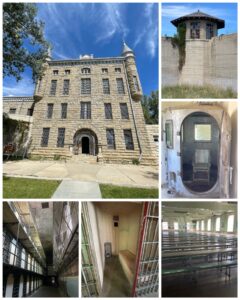 My next visit here in Rawlins would take me to the Wyoming Frontier Prison Museum. The first brick was laid for the Wyoming Frontier Prison – Utah’s first state penitentiary, in 1888. However, due to funding limitations and Wyoming’s notorious weather, the prison was not completed and opened until some 13 years late in 1901. It operated continuously until 1981 when it was closed. During its 80 year run, it would house over 13,000 inmates, including 11 woman. Due to constant overcrowding and the logistic challenges associated with having woman inmates, the woman were transferred to another facility, and this become a men only prison. There’s tons of interesting history here including early 1900 executions that were carried out using a Gallows device that hung its participants, to the use of a gas chamber (pictured at right, center right) that became the execution method of choice in 1936. Overall, this was kind of a creepy tour with row after row of tiny cells spread across several different cell blocks, and stories of living conditions and execution methods that would certainly be considered barbaric in todays standards.
My next visit here in Rawlins would take me to the Wyoming Frontier Prison Museum. The first brick was laid for the Wyoming Frontier Prison – Utah’s first state penitentiary, in 1888. However, due to funding limitations and Wyoming’s notorious weather, the prison was not completed and opened until some 13 years late in 1901. It operated continuously until 1981 when it was closed. During its 80 year run, it would house over 13,000 inmates, including 11 woman. Due to constant overcrowding and the logistic challenges associated with having woman inmates, the woman were transferred to another facility, and this become a men only prison. There’s tons of interesting history here including early 1900 executions that were carried out using a Gallows device that hung its participants, to the use of a gas chamber (pictured at right, center right) that became the execution method of choice in 1936. Overall, this was kind of a creepy tour with row after row of tiny cells spread across several different cell blocks, and stories of living conditions and execution methods that would certainly be considered barbaric in todays standards.
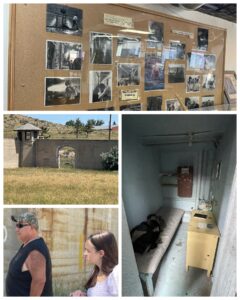 So the prison was closed in 1981 with plans to have it demolished. In fact, they started the demolition with the building that was used by the prisoners to make license plates. It was quickly realized that the effort to tear down a strengthened concrete structure was extremely difficult and costly. So, they stopped the plan and simply abandoned the facility. It remained abandoned until 1987 when a low budget “B” horror movie was filmed there. With the movie’s creative title “Prison”, it told the story of a long since dead prisoner whose spirit returns to seek revenge. Since the prison was abandoned, the movie studio was given free rein to make their film. This even included them carving out a large hole in the boarder wall to serve as a gated entrance. I was also treated to have a person among our touring visitors who was actually an extra in the film (at left, lower left). He and his daughter come to the prison each year to take a tour – a tradition they started when she was a little girl, and something they continue to do thru this day. Though he only had a minor role as an extra in a prison yard fight scene, he provided some interesting commentary and perspective about the film and its making. He said he wasn’t paid for his time or talent, but did get a literal free lunch on the day of shooting. After the filming was complete, it was decided that the building should be preserved. It soon after became a historic landmark, and the preservation process and public display as a museum began.
So the prison was closed in 1981 with plans to have it demolished. In fact, they started the demolition with the building that was used by the prisoners to make license plates. It was quickly realized that the effort to tear down a strengthened concrete structure was extremely difficult and costly. So, they stopped the plan and simply abandoned the facility. It remained abandoned until 1987 when a low budget “B” horror movie was filmed there. With the movie’s creative title “Prison”, it told the story of a long since dead prisoner whose spirit returns to seek revenge. Since the prison was abandoned, the movie studio was given free rein to make their film. This even included them carving out a large hole in the boarder wall to serve as a gated entrance. I was also treated to have a person among our touring visitors who was actually an extra in the film (at left, lower left). He and his daughter come to the prison each year to take a tour – a tradition they started when she was a little girl, and something they continue to do thru this day. Though he only had a minor role as an extra in a prison yard fight scene, he provided some interesting commentary and perspective about the film and its making. He said he wasn’t paid for his time or talent, but did get a literal free lunch on the day of shooting. After the filming was complete, it was decided that the building should be preserved. It soon after became a historic landmark, and the preservation process and public display as a museum began.
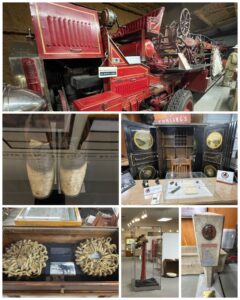 Across and down the street from the penitentiary was the Carbon County Museum. Like many local and regional museums, it featured lots of historical artifacts that were pertinent to the area. One section featured home furnishings and clothing styles from earlier periods, while another area honored local military heroes that gave up their lives in one of the many historical wars. There was a concrete road marker from the old Lincoln Highway (a right, bottom right), and an old safe that had been walled into the home and wasn’t found again until the home was in the process of being demolished. They even had snow shoes (at right, bottom left) that were used on horses in the deep Wyoming snow – something I’d never seen before. In the back in their garage, they even had a 52 foot 1920 fire truck. But, their most interesting piece were these shoes (at right, center left). George Francis Warden, aka Big Nose George, was an outlaw, horse thief and train robber. After he was caught and lynched for his crimes, a local doctor stole his body as he wanted to study the brain of a criminal. He also had a personal vendetta against him from being on a train that was delayed when it was being robbed by George. Anyway, he carried out his vengeance by peeling the skin from George’s chest and thighs, and had several items made from it to include a doctor’s bag, a coin purse, and these pair of shoes. How gruesome!
Across and down the street from the penitentiary was the Carbon County Museum. Like many local and regional museums, it featured lots of historical artifacts that were pertinent to the area. One section featured home furnishings and clothing styles from earlier periods, while another area honored local military heroes that gave up their lives in one of the many historical wars. There was a concrete road marker from the old Lincoln Highway (a right, bottom right), and an old safe that had been walled into the home and wasn’t found again until the home was in the process of being demolished. They even had snow shoes (at right, bottom left) that were used on horses in the deep Wyoming snow – something I’d never seen before. In the back in their garage, they even had a 52 foot 1920 fire truck. But, their most interesting piece were these shoes (at right, center left). George Francis Warden, aka Big Nose George, was an outlaw, horse thief and train robber. After he was caught and lynched for his crimes, a local doctor stole his body as he wanted to study the brain of a criminal. He also had a personal vendetta against him from being on a train that was delayed when it was being robbed by George. Anyway, he carried out his vengeance by peeling the skin from George’s chest and thighs, and had several items made from it to include a doctor’s bag, a coin purse, and these pair of shoes. How gruesome!
Cheyenne, WY
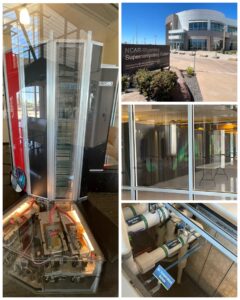 My final stop in WY would take me back to Cheyenne – a town that I had spent a week visiting at about this same time last year. I was only to be here for two nights which is good since I’d pretty much fully explored this area the last time in. That is with one exception! One of the places I was unable to visit last year was a huge disappointment. The National Center for Asmospheric Research (NCAR) Wyoming Supercomputing Center was high on my list of places to visit last year. Having played a major role in the design, build, and management of several computer data centers during my IT career, visiting this place would certainly tickle the geek in me. Besides, having my background, I would likely be one of the few if not the only person on a tour that would fully understand and appreciate all the technical details around the construction, and power & cooling infrastructure that goes into a facility like this – not to mention all the technical details of the compute and storage systems that reside here. But alas last year through the combined remnants of the COVID pandemic and having a new visitor center under construction, visitors were not welcome at the time. So, having the opportunity to be in the area once again this year, I made it a point to stop here again to get a second chance at a visit and tour. But as luck would have it, I would strike out a second time. Of all the weeks that I could be here, I had to choose the week that they shut down all tours in preparation for their ribbon cutting ceremony to officially launch the operational readiness of their new super computer named Derecho. So, I got to walk around their newly created visitor center, but missed the opportunity for a deep dive tour my geek self so desperately wanted. Oh well, I did get to see their early super computing system – a Cray 1 (at left, left side) which they used from 1977 thru 1989, as well as a glimpse into their data center through a glass window of their currently running super computer system known as Cheyenne (at left, center right) along with a small cutout depicting the lower level mechanical infrastructure. Not a total loss, but certainly not what I was hoping for. I guess I’ll have to schedule yet another pass through the area at some future point to take another swing at the plate.
My final stop in WY would take me back to Cheyenne – a town that I had spent a week visiting at about this same time last year. I was only to be here for two nights which is good since I’d pretty much fully explored this area the last time in. That is with one exception! One of the places I was unable to visit last year was a huge disappointment. The National Center for Asmospheric Research (NCAR) Wyoming Supercomputing Center was high on my list of places to visit last year. Having played a major role in the design, build, and management of several computer data centers during my IT career, visiting this place would certainly tickle the geek in me. Besides, having my background, I would likely be one of the few if not the only person on a tour that would fully understand and appreciate all the technical details around the construction, and power & cooling infrastructure that goes into a facility like this – not to mention all the technical details of the compute and storage systems that reside here. But alas last year through the combined remnants of the COVID pandemic and having a new visitor center under construction, visitors were not welcome at the time. So, having the opportunity to be in the area once again this year, I made it a point to stop here again to get a second chance at a visit and tour. But as luck would have it, I would strike out a second time. Of all the weeks that I could be here, I had to choose the week that they shut down all tours in preparation for their ribbon cutting ceremony to officially launch the operational readiness of their new super computer named Derecho. So, I got to walk around their newly created visitor center, but missed the opportunity for a deep dive tour my geek self so desperately wanted. Oh well, I did get to see their early super computing system – a Cray 1 (at left, left side) which they used from 1977 thru 1989, as well as a glimpse into their data center through a glass window of their currently running super computer system known as Cheyenne (at left, center right) along with a small cutout depicting the lower level mechanical infrastructure. Not a total loss, but certainly not what I was hoping for. I guess I’ll have to schedule yet another pass through the area at some future point to take another swing at the plate.
Final Thoughts
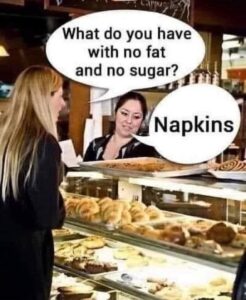 Well, all in all another successful few weeks of travel and touring through this country. It seems there are endless things to see and experience, which for me is more of a thrill and challenge to explore as much as possible. The next couple of weeks will be short hop stays that will take me through mostly unexplored areas of NE, IA, and IL. There’s no telling what interesting places I’ll find while traveling through these towns. But whatever they may be, I’ll certainly share them here in the Luv2RV blog. As a side note, I’ve already begun thinking about my next few years of travel. Next year will likely focus on NV, ID and MT, while 2025 will wrap up the first pass thru the country with visits to WA, OR, and CA. I’ve also wanted to take the Chicago to Santa Monica Rt 66 trail, and have decided that the 100th anniversary of the route in 2026 would be the perfect time to do so. Given that I would be taking the route hauling my condo on wheels along with me, I’ve come up with a plan that will allow me to safely navigate along the route, and yet fully enjoy the entire route in its purest form. I’ll share more details of those plans as I get further along with them. In the meantime, I’ll enjoy the remaining three months of this year’s itinerary, and look forward to all the adventures this year has yet to offer. Till next time, stay well and safe travels.
Well, all in all another successful few weeks of travel and touring through this country. It seems there are endless things to see and experience, which for me is more of a thrill and challenge to explore as much as possible. The next couple of weeks will be short hop stays that will take me through mostly unexplored areas of NE, IA, and IL. There’s no telling what interesting places I’ll find while traveling through these towns. But whatever they may be, I’ll certainly share them here in the Luv2RV blog. As a side note, I’ve already begun thinking about my next few years of travel. Next year will likely focus on NV, ID and MT, while 2025 will wrap up the first pass thru the country with visits to WA, OR, and CA. I’ve also wanted to take the Chicago to Santa Monica Rt 66 trail, and have decided that the 100th anniversary of the route in 2026 would be the perfect time to do so. Given that I would be taking the route hauling my condo on wheels along with me, I’ve come up with a plan that will allow me to safely navigate along the route, and yet fully enjoy the entire route in its purest form. I’ll share more details of those plans as I get further along with them. In the meantime, I’ll enjoy the remaining three months of this year’s itinerary, and look forward to all the adventures this year has yet to offer. Till next time, stay well and safe travels.
I only show a sampling of my adventure pictures here in the blog, and do so mostly in collage format for brevity and ease of reading. If you want to view an album containing individual full fidelity and hi-res images of all my travel pictures related to this specific blog, click the image below. Enjoy!

Thank you for sharing all this information from an area of the country I am not likely to visit. A wealth of information very nicely presented (except for the content about the doctor using Big Nose George’s skin to make various items!!!). I enjoyed the videos about Mike Masse and the Up House. Regarding the Final Thoughts cartoon – some fats are good for you – avocados and walnuts – but it is always a constant struggle to reduce sugar intake. Safe travels. See you in September.
Thanks for the comments Paula. I’m happy you get to view these places through my eyes, though I would certainly encourage you to continue your travels as well. So much to see, and so many Roadside attractions to visit. I agree about the skin products – definitely gruesome. Staying healthy, especially while on the road, is a constant challenge, and this cartoon struck home with me. Anyway, see ya soon.
Great blog again Bruce. You should write for an RV Or travel magazine!!! I enjoyed seeing the Up house. Very cool!! And the angry birds gave me a chuckle. Hope one of these days you get to see all of the NCAR Super computing center.
Safe travels and I look forward to the next blog!!
Thanks Debbie! I appreciate the comment about writing for an RV or travel magazine, but to be honest, that sounds too much like work! 😁 I’m perfectly satisfied doing my little blog, at my own pace, and in total control over the content. I do plan to take what I’ve done through the end of this year and have an initial three volume set of books created – giving a set to each of the girls. That way, they, and my grands that follow, can hopefully enjoy reading about my travels long after I’ve stopped the adventures. I’ll have an additional volume created for each subsequent two-years of travel until I decide to call it quits. So hopefully, several more volumes to come.
It was awesome catching up with you and listening to your stories. Looking forward to your next time in Utah!
The pleasure was all mine. It was really great catching up with you. I hope you enjoyed the pizza leftovers as much as I did! See ya the next time I’m in the area.